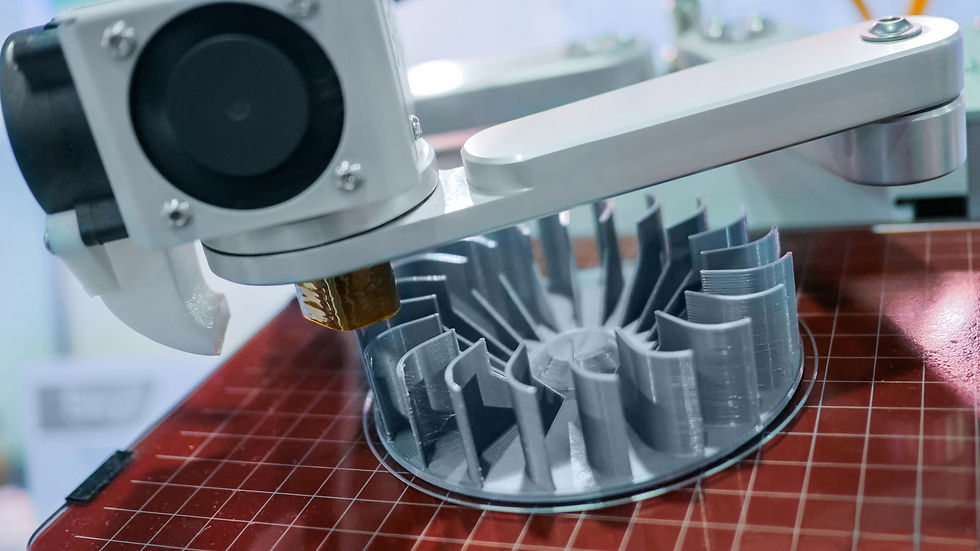Direct Drive vs. Bowden Feed 3D Printer Extruders: A Comprehensive Comparison
- Owen Krumm
- Aug 14, 2023
- 2 min read
When delving into the realm of 3D printing, a comprehensive grasp of extruder designs becomes paramount in achieving superior outcomes. Extruders occupy a pivotal role in directing filament to the hotend, and this article undertakes a thorough exploration of two primary extruder configurations: direct drive and Bowden feed. By immersing oneself in their structures, merits, and limitations, a more profound comprehension emerges regarding their influence on print quality and overall performance.
Direct Drive Extruder: A Comprehensive Analysis
The direct drive extruder epitomizes a design that intricately melds the extruder mechanism directly onto the printhead assembly. This close adjacency to the hotend yields a plethora of advantages that wield a substantial impact on print quality and material versatility.
Advantages of Direct Drive:
Enhanced Extrusion Control: The near alignment of the extruder with the hotend facilitates meticulous control over filament feeding, ensuring a consistent and high-caliber extrusion process.
Minimized Filament Path: Situated directly above the nozzle, the extruder diminishes filament travel distance, curtailing the likelihood of filament binding or tangling.
Flexibility in Filament Compatibility: Direct drive extruders excel in managing flexible and elastic filaments, enabling the crafting of intricate and dynamically responsive prints.
Multi-Material Printing: The direct drive configuration simplifies multi-material or multi-color printing, streamlining filament alterations and optimizing workflow efficiency.
Drawbacks of Direct Drive:
Increased Printhead Mass: Integration of the extruder onto the printhead introduces added weight, which potentially impacts print speeds and augments wear on belts and bearings.
Complexity in Maintenance: The extruder's proximity to the hotend necessitates careful attention during maintenance tasks, such as nozzle cleaning, given the compact design's potential challenges.
Bowden Feed Extruder: Unveiling the Design
In contrast, the Bowden feed extruder design segregates the extruder mechanism from the printhead, guiding filament through a PTFE tube (Bowden tube) from the extruder to the hotend.
Advantages of Bowden Feed:
Diminished Printhead Mass: By relocating the extruder away from the printhead, overall weight reduction ensues, translating to enhanced print quality through augmented movement precision and reduced vibrations.
Mitigation of Vibrations: The absence of the extruder on the printhead contributes to decreased vibrations, culminating in smoother and more intricate prints.
Longevity: Reduced weight on the printhead lessens component stress, potentially extending the printer's overall lifespan.
Drawbacks of Bowden Feed:
Filament Path Length: The elongated filament path through the Bowden tube introduces challenges in maintaining precise filament control, potentially leading to friction-related issues.
Filament Compatibility: Bowden extruders may encounter limitations with certain filament types, particularly flexible or abrasive materials, due to the elongated filament path and tube constraints.
Retraction and Responsiveness: The extended filament path can result in slower retraction and responsiveness, potentially causing issues like stringing or oozing between printed features.
Direct Drive, or Bowden Feed:
The choice between direct drive and Bowden feed extruders hinges on individual printing priorities. Opt for a direct drive extruder when placing a premium on precise print quality, material versatility, and seamless handling of diverse filament types. Conversely, a Bowden feed extruder suits those who prioritize speed, reduced printhead weight, and are willing to compromise on filament compatibility.
Still got questions?
Contact us with your extruder questions through our contact form or shoot us an email!
We also offer 3D Printing/Design Services.



Comments